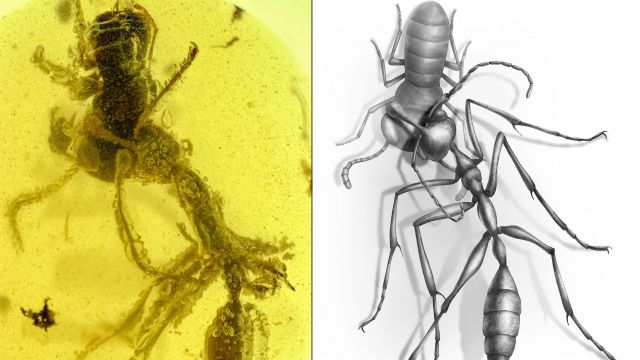The specimen, which was uncovered in Myanmar, shows the “enigmatic” insect predator locked in an embrace with its final victim, an extinct relative of a cockroach known as Caputoraptor elegans.
The newly identified ant species, known as Ceratomyrmex ellenbergeri, shows how the hell ant used deadly scythe-like mandibles in its mouth to pin prey against the horn-like appendages on its head.
While the mandibles of modern ants move in a horizontal motion, those of hell ants moved vertically, much like human jaws.
To see an extinct predator caught in the act of capturing its prey is invaluable
The findings have been described by scientists from the New Jersey Institute of Technology (NJIT), the Chinese Academy of Sciences and the University of Rennes in France in the journal Current Biology.
Phillip Barden, an assistant professor at the NJIT’s department of biological sciences and lead author on the study, said: “As palaeontologists, we speculate about the function of ancient adaptations using available evidence, but to see an extinct predator caught in the act of capturing its prey is invaluable.
“This fossilised predation confirms our hypothesis for how hell ant mouthparts worked… the only way for prey to be captured in such an arrangement is for the ant mouthparts to move up and downward in a direction unlike that of all living ants and nearly all insects.
“Since the first hell ant was unearthed about a hundred years ago, it’s been a mystery as to why these extinct animals are so distinct from the ants we have today.
“This fossil reveals the mechanism behind what we might call an ‘evolutionary experiment’, and although we see numerous such experiments in the fossil record, we often don’t have a clear picture of the evolutionary pathway that led to them.”
It is thought that the hell ant lineage, along with their killer predatory features, disappeared during an extinction event around 65 million years ago.
The researchers looked at 16 species of hell ants identified to date, focusing on the appendages they used to capture prey.
I think fossil insects are a reminder that even something as ubiquitous and familiar as ants have undergone extinction
Based on the different mouth and head shapes of these ancient ants, the researchers believe each species captured and killed prey in different ways.
While scientists may have some answers as to how these ancient ants thrived for nearly 20 million years, questions still remain as to how they became extinct while their modern counterparts flourished.
Prof Barden said: “Over 99% of all species that have ever lived have gone extinct.
“As our planet undergoes its sixth mass extinction event, it’s important that we work to understand extinct diversity and what might allow certain lineages to persist while others drop out.
“I think fossil insects are a reminder that even something as ubiquitous and familiar as ants have undergone extinction.”







